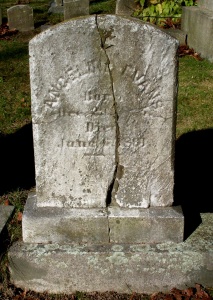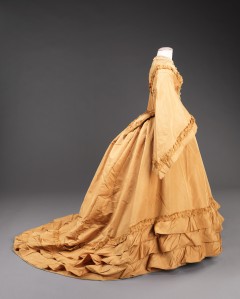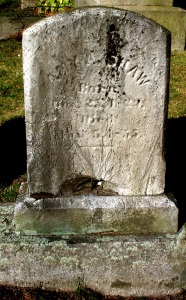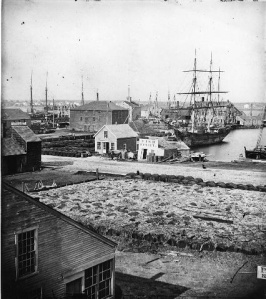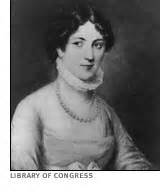May 25, 1862 is the day that Benjamin Hathaway’s domestic drama series jumped the shark for me.
Our 54-year-old, four-time widower had a grown daughter (Sarah, 22), two young daughters (Angeline, 6 and Helen, 5) and two sons, Benjamin, 8 and James, 2). The Hathaway household was in need of a woman with skills in childcare and home management. Surely, Benjamin’s eldest, Sarah, stepped into the breach left by her latest dead step-mother, but fostering four half-siblings would have been overwhelming.
If marriage was the solution to this dilemma, the best qualified candidates would be found among local widows with a child (or children) near in age to his own youngsters. Instead, Benjamin married another single woman, approaching 30 years his junior. Did he not consider his eldest – choice of bride under these circumstances was, at the least, unseemly.
The Brown family decreases…
Susan Elizabeth Brown was 26-year-old, school teacher, and her parents, Samuel Rounseville Brown (1809-1865) and Susan L. Ashley (1809-1854), were younger than her husband. Susan’s mother had died eight years before, and four siblings had died too. When she married, Susan had three, younger siblings, Josiah, Mary, and Emily.
Samuel R. Brown was a New Bedford carpenter, essentially, the same age as Benjamin Hathaway. Since 1854, he had also been a widower with children. Samuel had in Susan his own housekeeper, caregiver and childminder. Would he have supported his eldest daughter’s marriage to an older and encumbered man? Maybe.
Samuel’s only son, Josiah, was nearing 24 years, Mary, 22, and his youngest, Emily, 12; the Browns could get by without their big sister looking out for them. However, as the Browns’ lives played out, Susan never stopped looking out for her Brown siblings, even as she navigated her eventful marriage to Benjamin Hathaway.
Three months after Susan married, (August 10, 1862) her father married Ruth Barnaby (Evans) Rounseville, a widow with four children.(1) The 1865 state census of May 1, shows a household led by Samuel and Ruth Brown, with Emily Brown and four Rounsevilles (Caroline, 24, Imogene, 21, Walter, 15, and Mary, 12). Over in the Hathaway house, after Benjamin and Susan, there is Susan’s sister, Mary F. Brown, five Hathaways from prior marriages… and two more, Franklin (2) and Edmund B. (9 months). – Just three weeks later (May 21), Samuel Brown was dead at age 56.
It appears that Benjamin secured a house near his own, on Purchase Street where the unmarried Browns resided after their father’s death. The 1870 federal census, shows a household comprising Mary (30), who kept house, – Josiah (32), who was a baker, – and Emily (21) taught school, as her sister Susan had done. A ripple of happiness touched the Brown – Hathaway families the next year when Emily Ann married Albert Swift (November 28, 1871), though the idyll was a short one.
In November 1873, Emily (Brown) Swift died of consumption (tuberculosis), at the Hathaway Purchase Street address.(2) Six months after Emily (in May 1874), Susan’s brother Josiah died, also at the Hathaway house. It seems apparent that Susan took in her ailing siblings, and that she her sister Mary nursed them until the end. Susan and Mary were the sole survivors of their Brown family.
…while the Hathaways increase
Whether Susan had to cajole her husband to utilize his resources to help her family, or whether Benjamin was naturally disposed to generosity, I don’t know. On the face of it, Benjamin was demonstrably pleased to have a fresh, new missus.
Ten months after the wedding, Susan gave birth to a third son for Benjamin, Franklin Hathaway. The next year, Edmund Brown Hathaway was born, and Samuel Brown Hathaway came along in 1868. A daughter named, Susan Elizabeth Hathaway, arrived in Oct 1869. Finally, John Gael Hathaway was born in 1871, when Benjamin was 63 years old.
As early death was all too common in the 19th century, not all of Susan’s children survived. Edmund died at 14 months (dysentery); five-year-old Samuel succumbed to whooping cough in 1873, the same year her sister Emily died. However, the remaining three of his children with Susan reached adulthood when Benjamin, at long last, made one of his wives a widow in November 1890.
“And in the end, the love you take is equal to the love you make.” (3)
Ten years after Benjamin’s death, Susan remained in the family home on Purchase Street. The 1900 census shows she shared it with step-daughter, Sarah, and Sarah’s husband Frederick Mickell, unmarried stepdaughter, Angeline and stepson, Benjamin, as well as her children, Susan and John, and Mary Brown, her sister.(4) Early in 1903, Susan was diagnosed with stomach cancer and she died six months later on October 4.In New Bedford’s Oak Grove Cemetery, Benjamin Franklin Hathaway’s family plot is an interesting one. The eye is drawn initially to the granite obelisk thrusting skyward; one side reading, “IT IS FINISHED.” and below that, “B.F. Hathaway.” Around it are the matching, traditional, head stones.

Susan E. (Brown) Hathaway, Oak Grove Cemetery, New Bedford, MA [Find A Grave contributor, goose, 2015.]
However, in the matter of the towering gray stone, meant to portray masculine accomplishment, – it doesn’t work for me. Knowing the family history, it suggests an elephant seal surrounded by a harem.
Notes:
(1) Ruth Barnaby (Evans) Rounseville was the widow of Walter Scott Rounseville who died in California in 1853. In 1855, she was a neighbor of the Browns in Freetown.
(2) Emily’s husband, Albert H. Swift, died of the same disease that killed his wife, just two years later (1875).
(3) The closing lyrics of “The End” by Paul McCartney from the Beatles’ Abbey Road album, 1969.
(4) Susan’s sister, Mary Frances Brown, never did marry. She continued to live with the Hathaways until her death in 1913.
Sources:
New England Historic Genealogical Society, Boston, Massachusetts; Massachusetts Vital Records, 1840-1911; New Bedford marriages 1862.
New England Historic Genealogical Society, Boston, Massachusetts. Massachusetts State Census 1855, 1865.
New England Historical and Genealogical Register; Vol 20 (1866); Posterity of William Davis of Freetown; Gen. Ebenezer W. Peirce.
Ancestry.com; Bristol County, Massachusetts Probates, Vol 256-257,1889-1891.Ancestry.com; Massachusetts, Death Records, 1841-1915.
National Archives and Records Administration (NARA); United States Census 1840, 1850, 1860, 1870, 1880, 1900, 1910.
Find A Grave; www.findagrave.com/
Wikipedia; The End; https://en.wikipedia.org/wiki/The_End_(Beatles_song)
Wikipedia: Northern elephant seal; https://en.wikipedia.org/wiki/Northern_elephant_seal


![Obelisk inscribed "It is finished," B.F. Hathaway monument in Oak Grove Cemetery (New Bedford, MA) [Find A Grave contrbutor, goose ]](https://pooririshandpilgrims.files.wordpress.com/2017/03/bf-hathaway-it-is-finished.jpg?w=75&h=300)
![Worn by a New Hampshire bride in 1857. [Smithsonian National Museum of American History]](https://pooririshandpilgrims.files.wordpress.com/2017/02/1855-smithsonian-ah.jpg?w=200&h=300)
